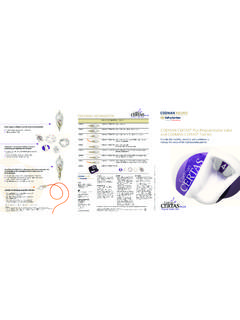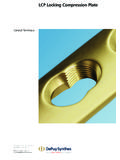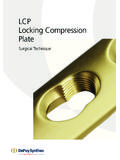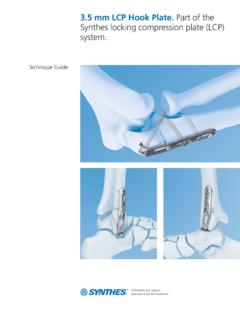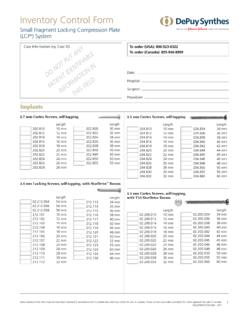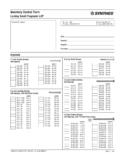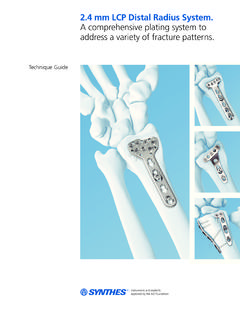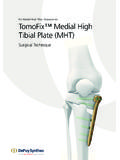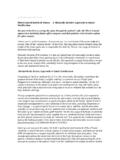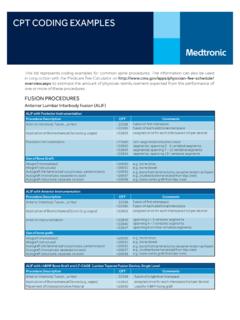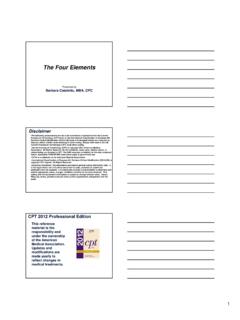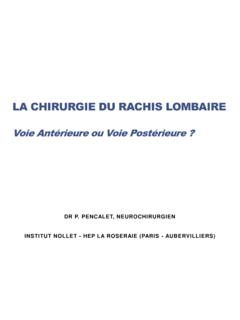Transcription of Zero-P and Zero-P chronOS. Zero profile anterior cervical ...
1 This publication is not intended for distribution in the and implantsapproved by the AO and Zero-P chronOS. zero profile anterior cervical interbody fusion (ACIF) TechniqueImage intensifier controlThis description alone does not provide sufficient background for direct use of DePuy Synthes products. Instruction by a surgeon experienced in handling these products is highly , Reprocessing, Care and MaintenanceFor general guidelines, function control and dismantling of multi-part instruments, as well as processing guidelines for implants, please contact your local sales representative or refer to: general information about reprocessing, care and maintenance of Synthes reusable devices, instrument trays and cases, as well as processing of Synthes non-sterile implants, please consult the Important Information leaflet (SE_023827) or refer to: Technique Zero-P and Zero-P chronOS DePuy Synthes 1 Table of ContentsIntroduction Zero-P and Zero-P chronOS.
2 zero profile anterior cervical interbody fusion (ACIF) device. 2 Zero-P pre-filled with chronOS 4AO Principles 7 Indications and Contraindications 8 Surgical Technique Preoperative Planning 9 Considerations for Use Adjacent to a Prior fusion 10 Patient Positioning, Exposure and Disectomy 12 Implant Insertion 14 Screw Fixation Option A: Aiming Device 20 Option B: Drill Guide and Freehand Screw 28 Option C: Threaded Drill Guide and Freehand Screw 34 Option D: Awl and Freehand Screw 40 Option E: Angled Instruments 46 Product Information Implant Removal 50 Implants 54 Instruments 57 Set 61 Dismantling Guide Screwdriver Stardrive 64 Holding Sleeve for Screws 65 Handle with Quick Coupling 66 Awl B mm, with Sleeve 67 Bibliography Bibliography 682 DePuy Synthes Zero-P and Zero-P chronOS Surgical TechniqueZero-P and Zero-P chronOS.
3 zero profile anterior cervical interbody fusion (ACIF) ACIF implantZero-P acts as a stand-alone implant for use in cervical inter-body fusions6 12. Its design combines the functionality of a cervical interbody spacer and the benefits of an anterior cervical profileReduces risk of dysphagiaThe implant is contained within the excised disc space and does not protrude past the anterior wall of the vertebral body as do anterior cervical plates. This zero anterior profile may be beneficial in reducing the occurrence and severity of postoperative dysphagia1, 2, 3, 4. In addition, preparation of the anterior surface of the vertebral body is minimized because the implant does not lie against this adjacent level ossificationIt has been shown that cervical plates placed near adjacent level discs can contribute to bone formation near or around the adjacent level which may lead to future complications5.
4 Zero-P minimizes this risk, as it remains as far as possible from the adjacent level disc of use Because plate and spacer are preassembled, the plate is automatically aligned upon implant insertion. This avoids the process of aligning and realigning an anterior cervical plate. The Zero-P screws have a one-step locking conical head which locks the screw to the plate by simply inserting and tightening the rgical T echnique Zero-P and Zero-P chronOS DePuy Synthes 40 55 mm12 mm5 mm7. 5 m mm15 mm17. 5 m mm17. 5 m 40 55 PEEK interbody spacer Radiopaque marker for posterior visualization during imaging Spacer component is made of pure medical grade PEEK Optima (Polyetheretherketone) PEEK Optima does not contain carbon fi bers reducing the risk of systematic uptake and local connective tissue formation Teeth on the implant surface provide initial stabilityTitanium alloy plate Provides a secure, rigid screw locking interface Stresses in plate are decoupled from spacer through an innovative interfaceLocking head screws Screws form a bone wedge with a 40 5 cranial/caudal angle and medial/lateral angle One-step locking screws Self-tapping screws improve thread purchase Trilobular thread cutting fl utes are self-centering4 DePuy Synthes Zero-P and Zero-P chronOS Surgical TechniqueMacropores (100 500 m)Micropores (10 40 m)
5 The use of b-tricalcium phosphate in the spinal column is a valuable alternative to allografts and autografts, even when larger amounts are friendly, reduces surgery time No extra filling step required, implant can be directly used after unpacking. Low patient morbidity as there is no need for secondary surgery to remove autologous bone*. The operation time is also shortened. Easy handling as the cage is only saturated with blood or bone marrow.* Studies have demonstrated that the chronic pain rate can still be , two years after iliac crest surgery17, 19 Zero-P and Zero-P chronOS. Zeroprofi le anterior cervical interbody fusion (ACIF) pre-filled with chronOSSurgical Technique Zero-P and Zero-P chronOS DePuy Synthes 5100%90%80%70%60%50%40%30%20%10%0%10%20% 30%40%0% <100 160 240 320 400 500 >5004 weeks12 week sTime24 weeksm Medullary Spacem Bone Matrixm chronOSTMP ercent by VolumeHistomorphometric volume-percent analysis for three different healing periods; (Buser, D.)
6 Et al. 1998) 21 Size distribution of macroporesRemodeling and substitution of chronOS (24 weeks in an animal model). Some chronOS Granules are still lined by woven bone, other parts are directly covered by lamellar bone, or are exposed to the marrow space (arrow) where they undergo degradation by osteoclasts (Buser et al, 1998).21 OsteoconductiveInterconnecting macropores of a defined size (100 500 m) facilitate bone ingrowth. Interconnected micropores (10 40 m) allow an optimum supply of nutrients. The patient s blood, blood platelet concentrate or bone marrow aspirate enhances the properties of chronOS required for Zero-P chronOS implant can be simply and quickly satu-rated with the patient s own blood or bone marrow during surgery. This supports bone integration and ensures rapid ongrowth to the resorption of b-tricalcium phosphatechronOS consists of pure b-tricalcium phosphate and is structurally and chemically similar to bone.
7 Osteoclasts re-sorb chronOS like natural bone and degrade it of new host bone within 6 18 monthsWhile resorption is taking place, new bone is being formed. The key to success of chronOS is the remodeling process. Resorption and new bone formation happen is the critical factor for a bone graft to remodel into natural bone. If the resorption is too rapid, the osteoblasts lose the scaffold needed for the formation of new bone. If the resorption is too slow or incomplete, the graft will not be replaced by bone in an adequate time span. chronOS has been designed to remodel in an ideal time span. It is being replaced in the human body by host bone in 6 to 18 months; depending on the indication and the patient s no adverse reactionsAll investigations, according to ISO 10993 series, demon-strate the excellent biocompatibility of chronOS. No adverse reactions have been observed in the more than 25 years of clinical applications (see bibliography16 23).
8 Pore size, m6 DePuy Synthes Zero-P and Zero-P chronOS Surgical Technique9876543210abcFlexionExtensionAx ial rotationLateral bendingAngle (Degree)IntactCage stand aloneCSLPV ectra-TTest deviceBiomechanical testing has shown the stability of the implant to be similar to that of traditional plates and new stand-alone cervical anterior interbody fusion device: comparison with established anterior cervical fixation devices Scholz M, Reyes PM, Schleicher P, Brantley AGU, Baek S, Kandziora F, Marciano F, Crawford NRAbstractStudy design: A new low- profile cervical interbody fusion cage with integrated anterior fixation was compared biome-chanically to established anterior cervical devices using non-destructive flexibility testing in human cadaveric : To evaluate the fixation properties of the new stand-alone device (test device) and compare these proper-ties with established fixation methods under various loading modes.
9 The hypothesis is that the new device will provide stability comparable to that provided by an anterior cervical cage when supplemented with an anterior plate. Methods: Twenty-four human cadaveric C4 C7 cervical spines were loaded non-destructively with pure moments in a non-constrained testing apparatus to induce flexion, exten-sion, lateral bending, and axial rotation (maximum Nm) while angular motion was measured optoelectronically. The specimens were tested: 1) intact (N = 24) 2) after discectomy and anterior stabilization a) PEEK cage + CSLP [cage+CSLP] (N = 8) b) PEEK cage + Vectra-T [cage+Vectra-T] (N = 8) c) PEEK cage with integrated anterior fixation [test device] (N = 8) 3) after ventral plate removal of group 2a and 2b [cage-only] (N = 16). Stability similar to that of an anterior spacer and plateResults: All fi xation techniques decreased range of motion (ROM) and Lax Zone (LZ) (P< ) in all test modes com-pared to the intact motion segment and cage-only group.
10 (All decreased, but one wasn t significant (p< ). Test de-vice vs. cage-only group in extension p = ). There were no significant differences between the test-device and cage + CSLP or cage + Vectra-T. Conclusions: The test-device provided a similar biomechani-cal stability to that of the established anterior fusion tech-nique using an anterior plate plus cage and has a potentially lower peri- and post-operative morbidity. These results sup-port progression to clinical trials using the test-device as a stand-alone and Zero-P chronOS. Zeroprofi le anterior cervical interbody fusion (ACIF) Technique Zero-P and Zero-P chronOS DePuy Synthes 7In 1958, the AO formulated four basic principles, which have become the guidelines for internal fixation13. They are: Anatomical reduction Stable fixation Preservation of blood supply Early, active mobilizationThe fundamental aims of fracture treatment in the limbs and fusion of the spine are the same.
